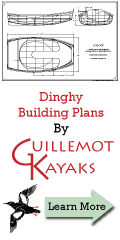> I�m preparing to make my first strip kayak. I don�t have a table saw so I
> intend to cut the strips on my bandsaw. The finished cut will not be as
> good as a table saw and I�m wondering whether to allow for this in the
> cut. I�m looking to build Nick Schade�s Grt. Auk with the recommended
> strips being a quarter inch thick.
> Should I cut them at a quarter inch or greater?
> How much should I allow?
> Is there any benefit to planing prior to fit, although I�m a bit daunted
> by this as I only have hand planes (1 electric)?
> Any views/experiences/advice would be very appreciated. I obviously don�t
> want to lay strips and find that I�m sanding through them attempting to
> get a final finish because I�ve cut them wrong.
> Pete Griffiths, Rufford, England
Pete,
Since people have successfully constructed kayaks with 3/16 and even 1/8 th inch thick strips, it seems unlikely that you could sand a strip too thin. You would really have to be working at it.
Cut your strips at 1/4 inch, or as close to that as you can get. If you have to err, err on the slightly larger size. hat might be the thickness of a pencil line, or a few thousands of an inch. Should you slip and get a really thin spot in a strip, cut through that strip at the mistake, then trim each piece back until it is the proper thickness, and use these two shorter strips wherever they will fit.
I'm trying to decipher your comments on planes. Do you actually have the use of an electric plane? If so you can make a simple jig that will make it into a surface planer, and give you superior consistency in your strips.
Simply cut a section of 2x4 or 2x6 stock about 3 feet long (can be longer if you wish. This will be the work table for your plane. near the middle of this board place two spacers. These can be made of your strip stock. They should be at lesst the length of the baseplate of your plane. use a small nail or brad at each end to secure them to the 2x4. Leave enough room between them (at least an inch) so that you can push a strip easily between them. Set the planer on top of this, and clamp it in place as best as you can. Now, when you push your strips along the table of this device the planner will smooth one side. Add finger boards to hold the strip down as it is machined.
After you have done ALL your strips, replace the two spacers with two more shic are slightly thinner. Flip your strips over and run them all through the planer again. This time it will clean up the second side. Afer all the strips have gone through this, they will all be exactly the same thickness, and very smooth. this will cut down on sanding by a considerable amount. You can make similar jigs for mounting other tools (routers or sanders) a fixed distance above the work table. These will cut slower, so you will just feed the stock through slower, but they can also smooth and even the strip stock.
If you are going to bead and cove the strips, you will want all your strips to be very close to identical in thickness. You will also need a router. With the proper bit, this can be used instead of a plane to get your strips to the desired size.
Probable the cheapest too you can use for this task is a drum sanding attachment for an electric drill. These are typically made of a hard rubber compound and take cylinders of sandpaper, but you can also make your own from a short length ( 2 or 3 inches) of large diameter dowel rod, such as the sowel rod used in closets for hanging clothes. Drill a 1/4 inch hole through the center of this, pass a 1/4 inch carriage bolt through, and secure it by threading on a washer an nut, and tightening the nut. Chuck the remaining end of the bolt into your electric drill. Probably this is NOT going to be perfectly centered, but you can true with some sandpaper while it is spinning it. ( soft woods -- even balsa -- will make this part a simple process. When it is running true, wrap it with sand paper, and use it as a sanding drum.
You can improve on this by mounting a dowel on a steel or brass rod that is supported at each end by bearings. Depends on how fanay you want to make this.
If you don't want to go to all this trouble, then install the strips with the roughest side out, as it is MUCH easier to sand ( or plane) the outside of the hull than it is to sand the inside. If the wood is really rough, though, smoothing one side (the inside) with a sander before installing the strip will make later interior sanding easier.
Have you checked to see if there are places near you which might rent tools for a few days? If so, consider that possibility.
Hope this helps
Paul G. Jacobson
Messages In This Thread
- Cutting Strips - advice needed
Peter Griffiths -- 2/2/2000, 4:01 pm- Re: Cutting Strips - advice needed
Paul G. Jacobson -- 2/2/2000, 7:00 pm - Re: Cutting Strips - check bandsaw adjustment
Hank -- 2/2/2000, 6:28 pm - Re: Cutting Strips - advice needed
Earl Bailey -- 2/2/2000, 4:42 pm- Re: Cutting Strips - advice needed
Tony -- 2/2/2000, 6:29 pm
- Re: Cutting Strips - advice needed
- Re: Cutting Strips - advice needed
Derek -- 2/2/2000, 4:35 pm
- Re: Cutting Strips - advice needed



